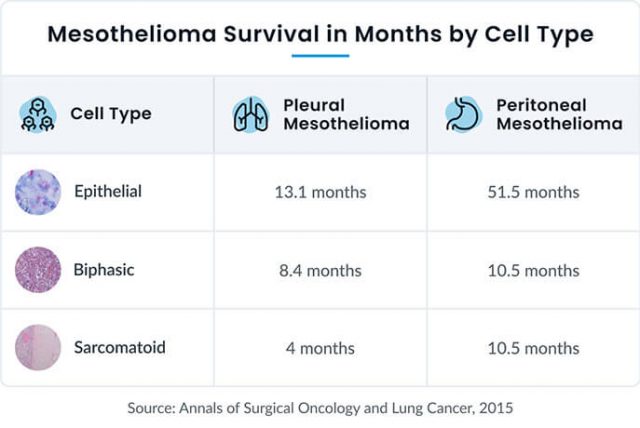Mesothelioma Life Expectancy & Survival Rates
The average life expectancy for all types of mesothelioma is around one year. Pleural patients diagnosed early live an average of 22 months, while peritoneal patients may live longer than five years with aggressive treatment. The five-year survival rate is 10% for pleural mesothelioma and 52% for peritoneal mesothelioma.
What Is Mesothelioma Life Expectancy?
Mesothelioma life expectancy is the amount of time someone is expected to live with the disease. The average is around one year.
Medical professionals use the terms life expectancy and survival rate on a regular basis to discuss prognosis. Although they are similar, they are not interchangeable. Learning more about these terms may help you understand your prognosis a little better.
Life expectancy is the estimated amount of time someone will live after a diagnosis. It is measured in months and years.-
Survival rate is the percentage of people who survive for a certain period of time. These rates are usually measured in one-, three- and five-year increments. -
Prognosis is the overall outlook of how a disease will impact a person’s life.
While some survivors of mesothelioma have lived for years with the cancer and died of another cause, most cases of mesothelioma are terminal.
How Long Do You Live After Being Diagnosed with Mesothelioma?
Most people live around one year after they receive a mesothelioma diagnosis. Patients who are diagnosed early and elect aggressive treatment are more likely to live for several years.
| One Year | Two Years | Five Years | |
|---|---|---|---|
| Pleural Mesothelioma | 40% | 18% | 5% |
| Peritoneal Mesothelioma | 50% | 35% | 18% |
Mesothelioma Life Expectancy Factors
Your life expectancy with mesothelioma is influenced by several factors, including the cancer’s stage, location and cell type, as well as personal health factors unique to each patient.
Stage
Doctors describe how far the cancer has spread in terms of mesothelioma stages, ranging from stage 1 to stage 4 mesothelioma. A higher stage number means cancer cells have spread further throughout the body. This leads to a shorter mesothelioma life expectancy.
Instead of reporting survival by conventional staging, the American Cancer Society began reporting pleural mesothelioma survival rates based on staging the cancer as localized, regional or distant. These are the staging categories used by the Surveillance, Epidemiology and End Results program, known as SEER. The following five-year survival rates represent pleural mesothelioma cases diagnosed between 2009 and 2015.
| SEER Stage | Five-Year Survival Rate |
|---|---|
| Localized | 20% |
| Regional | 12% |
| Distant | 8% |
| All stages combined | 10% |
Location
- Pleural mesothelioma forms in the lining of the lungs, and it is the most common type.
- Peritoneal mesothelioma forms in the lining of the abdomen, and it is the second-most common type.
- Pericardial mesothelioma forms in the lining of the heart, and it accounts for less than 1% of cases.
- Testicular mesothelioma forms in the lining of the testes, and it also accounts for less than 1% of cases.
The average life expectancies for the different types of mesothelioma vary significantly.
| Pleural mesothelioma | 12 months |
| Peritoneal mesothelioma | 60 months |
| Pericardial mesothelioma | 6-10 months |
| Testicular mesothelioma | 24 months |
Cell Type
Mesothelioma cells can form in different patterns, which determine the cell type of the tumor. Epithelioid mesothelioma is the most common type as well as the easiest to treat. Sarcomatoid and biphasic mesothelioma are more resistant to treatment, which has a negative impact on survival.

Patient Age, Gender and Overall Health
Younger patients usually have a better mesothelioma prognosis. Their bodies have stronger immune systems and a greater ability to recover from surgery. More than half of patients under 50 live at least one year after a mesothelioma diagnosis, compared to less than one-third of patients over 75.
Mesothelioma statistics show women with pleural mesothelioma have a better prognosis than men because they respond to treatment better. A review of data from the Surveillance, Epidemiology and End Results program shows that 16.3% of women with mesothelioma survived for five years, compared to only 7.3% of men.
Your overall heath has a significant impact on how well your body may tolerate cancer treatment. A patient in poor health may not respond well to treatment and may not qualify for aggressive treatment plans. Patients in good health typically respond better to treatment and may live longer with mesothelioma.
Other Factors
- History of Smoking: While smoking does not impact a person’s risk of developing mesothelioma, it does impact their overall heath. Smokers may not respond as well to treatment and may not live as long with mesothelioma.
- Lifestyle Choices: Similar to the health impacts of smoking, other lifestyle choices, such as how much alcohol you consume, have an impact on your overall health.
- Blood Characteristics: Patients with low hemoglobin, high platelet count and high white blood cell count have a poorer prognosis with mesothelioma.
Mesothelioma Survival Rate
The mesothelioma survival rate is a figure that captures how many people survived a certain amount of time with mesothelioma. The five-year survival rate for all types of mesothelioma is around 10%.
This data is gathered and processed by the U.S. Centers for Disease Control and Prevention, and it takes several years to crunch the numbers. For this reason, survival rate data represents cases of mesothelioma that happened a number of years ago. These figures don’t represent recent advancements in mesothelioma treatment because the data is several years old.
While life expectancy figures estimate how long someone might live with mesothelioma, survival rate data looks back at the number of people who lived for a period of time with mesothelioma.
| Pleural mesothelioma | 10% |
| Peritoneal mesothelioma | 52% |
Mesothelioma Survival Rates by Stage
Staging systems have been established for the two common types of mesothelioma, pleural and peritoneal. Survival rate data by mesothelioma stage is available for these types of mesothelioma.
The other two types, pericardial and testicular mesothelioma, do not have official staging systems. Unfortunately, survival data by stage is not available for these two rare types of mesothelioma.
| SEER Stage | Five-Year Survival Rate |
|---|---|
| Localized | 20% |
| Regional | 12% |
| Distant | 8% |
| All stages combined | 10% |
| Peritoneal Cancer Index Stage | Survival in Months |
|---|---|
| Localized | N/A |
| Regional | 56 months |
| Distant | 26 months |
| All stages combined | 67 months |
Survival Rate by Gender & Age
Women with mesothelioma have significantly better survival rates than men. Researchers do not understand exactly why, but they suspect hormonal differences play a role. According to the Surveillance, Epidemiology and End Results program, between 2010 and 2016, the five-year survival rate for mesothelioma in women was 16.3% and 7.3% in men.
Age also has a significant impact on survival rates. The younger a patient is, the better their survival rate.
| Age | Five-Year Survival Rate |
|---|---|
| Ages under 45 | 42.2% |
| Ages 45-54 | 23.3% |
| Ages 55-64 | 14.3% |
| Ages 65-74 | 8.9% |
| Ages 75+ | 4.6% |
| Ages under 65 | 19.9% |
| Ages 65+ | 6.4% |
Survival Rate by Race & Ethnicity
Mesothelioma primarily develops in white individuals, who make up approximately 95% of cases.
The Surveillance, Epidemiology and End Results program provides five-year survival rate data for white and black individuals. Data shows the survival rate was 11.6% in 2016 for white individuals and 17.3% for black individuals.
Improving Mesothelioma Life Expectancy
The best way to improve mesothelioma life expectancy is to work with a mesothelioma specialist who can create a treatment plan tailored to your specific diagnosis and personal health.
Treatments for mesothelioma that are most effective include surgery, chemotherapy, radiation therapy, Tumor Treating Fields and immunotherapy. Combining two or more of these treatments can extend survival even further.
- Eat a balanced diet high in protein to help you recover from treatment.
- Exercise regularly to fight off feelings of fatigue and avoid muscle loss.
- Get plenty of good sleep to help your body recover from treatment.
- If you’re a smoker, quitting immediately will boost your overall health.
- Talk with a loved one or mental health therapist to address your mental and emotional health.
- Ask your oncologist for a referral to a palliative care specialist to improve your quality of life.
- Talk to your oncologist about complementary therapies that won’t interfere with your treatment plan.
Mesothelioma Life Expectancy with Treatment
Treatment improves life expectancy among people with pleural mesothelioma by an average of six months to a year. Peritoneal patients have a 50% chance of living longer than five years if they elect cytoreductive surgery with heated chemotherapy.
The vast majority of long-term mesothelioma survivors credit their survival to the life-extending procedures that kept their cancer under control. It is relatively common for mesothelioma patients to undergo several different treatments to control tumor growth.
Mesothelioma Life Expectancy Without Treatment
Not everyone with mesothelioma wants to undergo treatment. Unfortunately, forgoing treatment has a significant impact on life expectancy. Without treatment, pleural patients live around eight months and peritoneal patients live around six months.
Palliative care is provided to mesothelioma patients who do not want to go through anti-cancer treatment. This type of care aims to control symptoms of mesothelioma and improve quality of life, which sometimes helps people live longer with the cancer.



